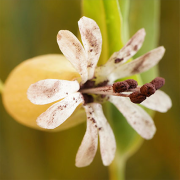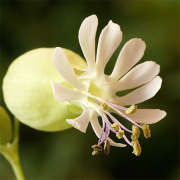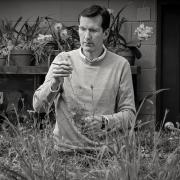Think of all the alarming “new” creatures you may have first heard in recent months, from murder hornets to lantern flies to poisonous spiny puss caterpillars. These—and other, more prosaic species—all existed before 2020. Their appearance in places they never lived before reflects how human activities and environmental change are rapidly redistributing species around the globe. This is good news for bacteria, viruses and other disease-causing microorganisms, which suddenly have the opportunity to exploit new hosts. It’s bad news for everyone else. One way to curb the threat of emerging new diseases is to predict how readily they might spread and why certain populations may prove resistant to infection. The National Institutes of Health, working with the National Science Foundation and the USDA, have awarded Professor of Biology Michael Hood a four-year grant to do just that. He spoke with us about his work.
2021: Winter Could 10,000 Carnations Save the World?



Hood’s lab studies diseased
(top) and healthy relatives
of the carnation family.
Why is this study important?
The emergence of new diseases is a major concern for human populations. Our engagement with emerging diseases has been almost entirely reactive, but knowing the best strategy depends upon an ability to predict how new host-pathogen combinations are likely to behave.
What are your primary goals?
We’re interested in what underlies the genetic variation for the risk of new disease emergence. We are trying to approach this question using a biological model system that is safe and easy to control. It will allow us to do very large experiments, both in the laboratory and also in the field.
How does your project break new ground?
About a decade after the emergence of HIV/AIDS, scientists started to look at whether certain human populations were genetically more or less susceptible to infection. In fact, some portions of the human population had higher levels of resistance to HIV, and some had lower resistance. The causes of such resistance variation to a new disease are a neglected area of study. We’re comparing populations and looking at the factors that might predict their susceptibility. In particular, we ask how current diseases circulating within populations may either predispose that population to a new disease or make them more resilient against it.
Are you studying this in people?
We’re not working on humans, although the questions that we’re asking are relevant to human diseases. We’re using a plant model (a wild relative of the carnation family) and a fungus model (Microbotryum) for these interactions. We’re also using a lot of mathematical theory to discern fundamental principles about variation in the risk of disease emergence. We hope the information can be used by people who are studying animal, plant or human diseases.
Where and how will you do your experiments?
Our fieldwork location in the Southern European Alps is a hotspot for the diversity of the potential host species in the carnation family. So there’s this risk of diseases being transferred from one host to another. Because our model organism is easy to grow, we can very readily set up experiments in the Amherst greenhouse with as many as 10,000 individual plants. Over a year, we can run several experiments and collect a lot of data, giving us the ability to run more powerful statistical analyses of whether certain groups of hosts are more likely to experience the emergence of a new disease.
Flowers: courtesy Michael Hood; Hood: David Le ’17E